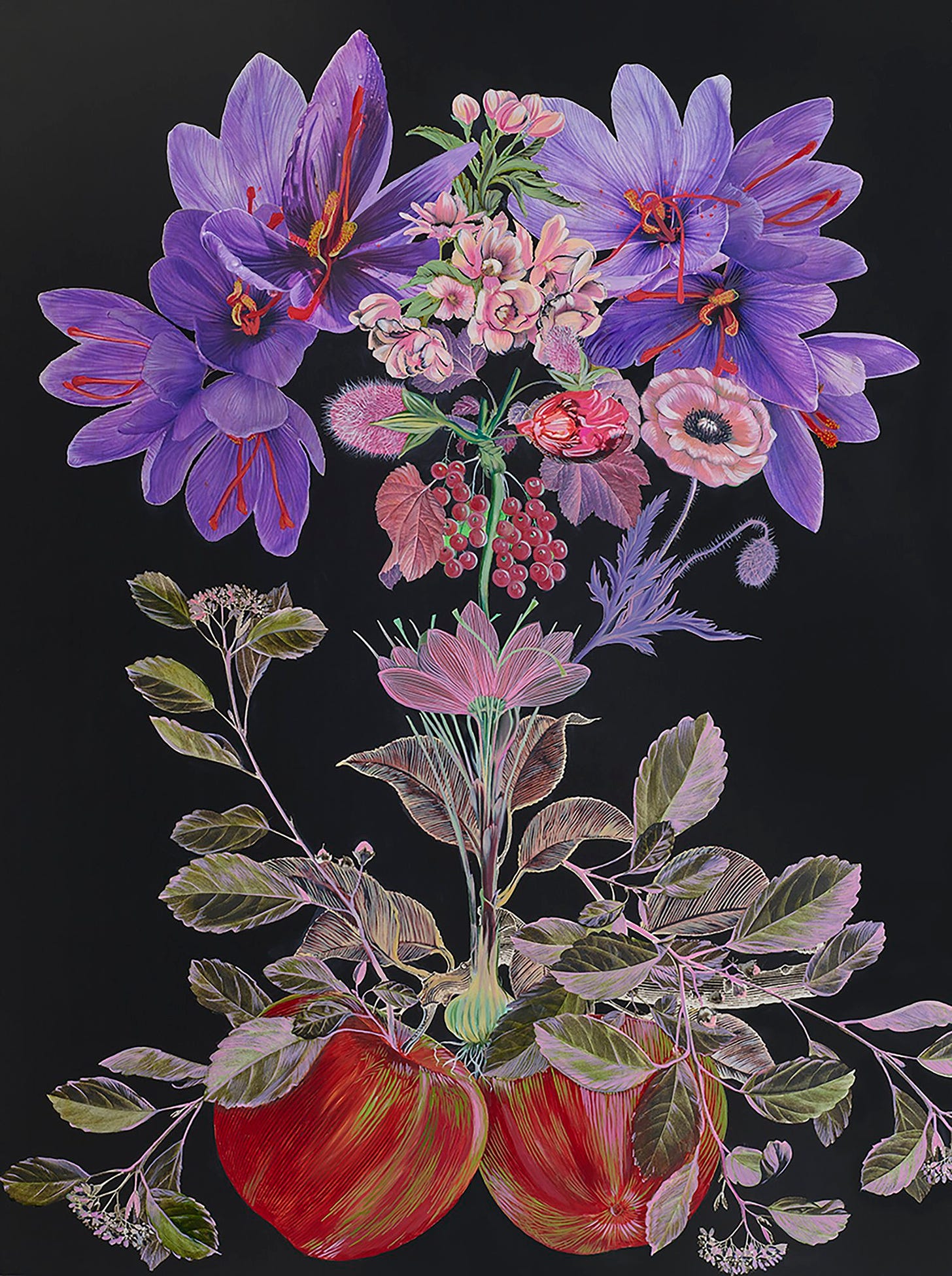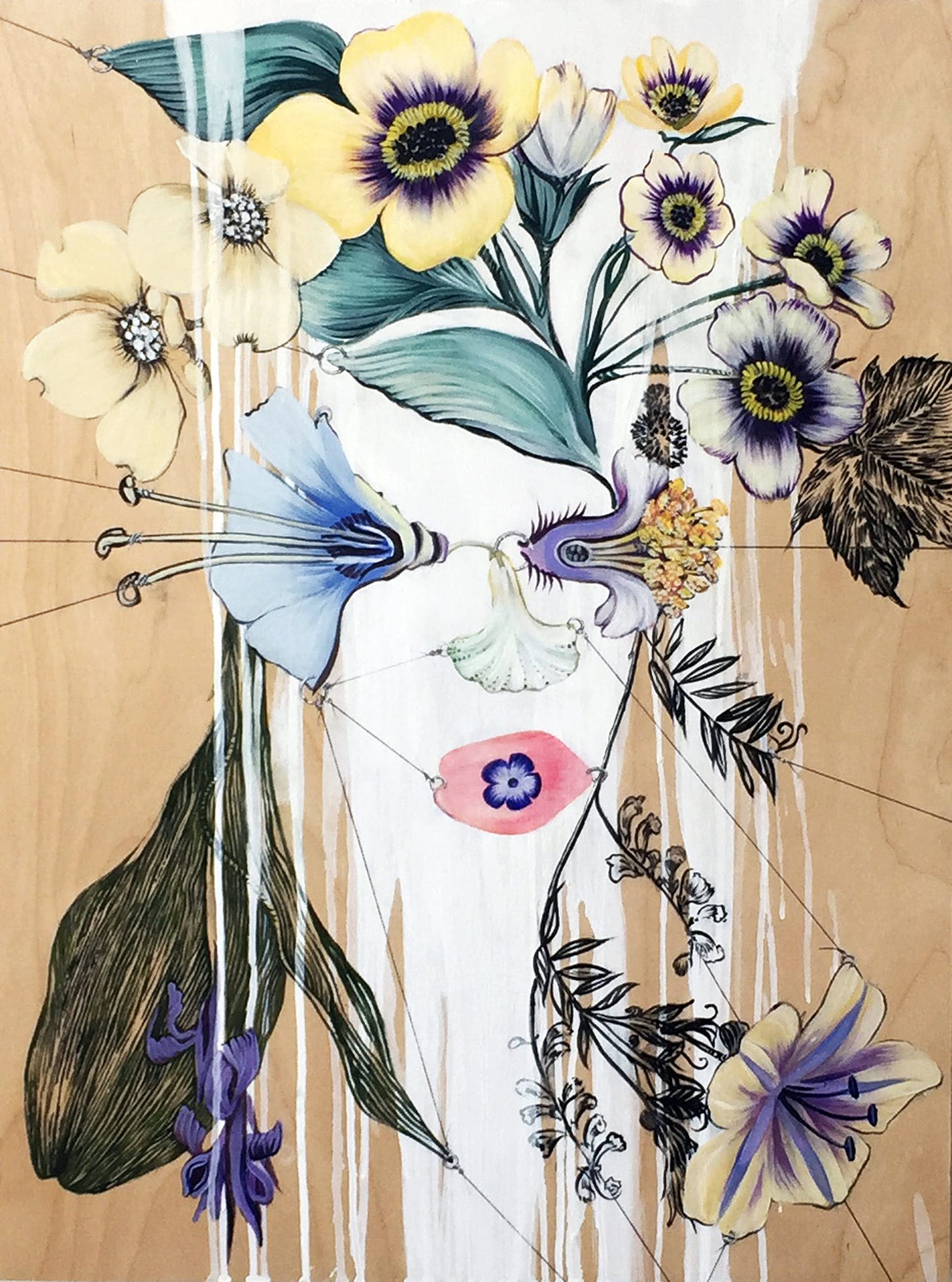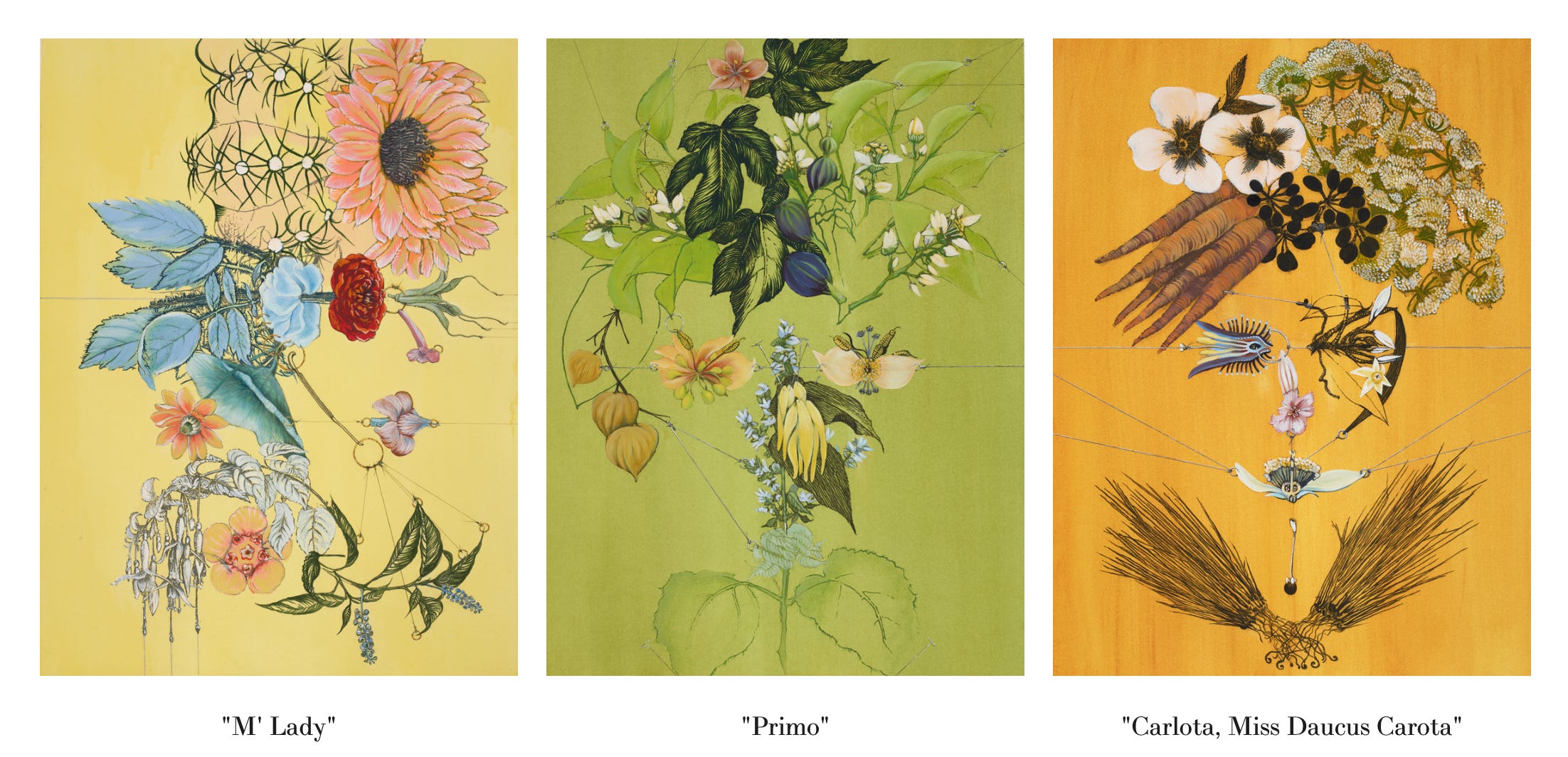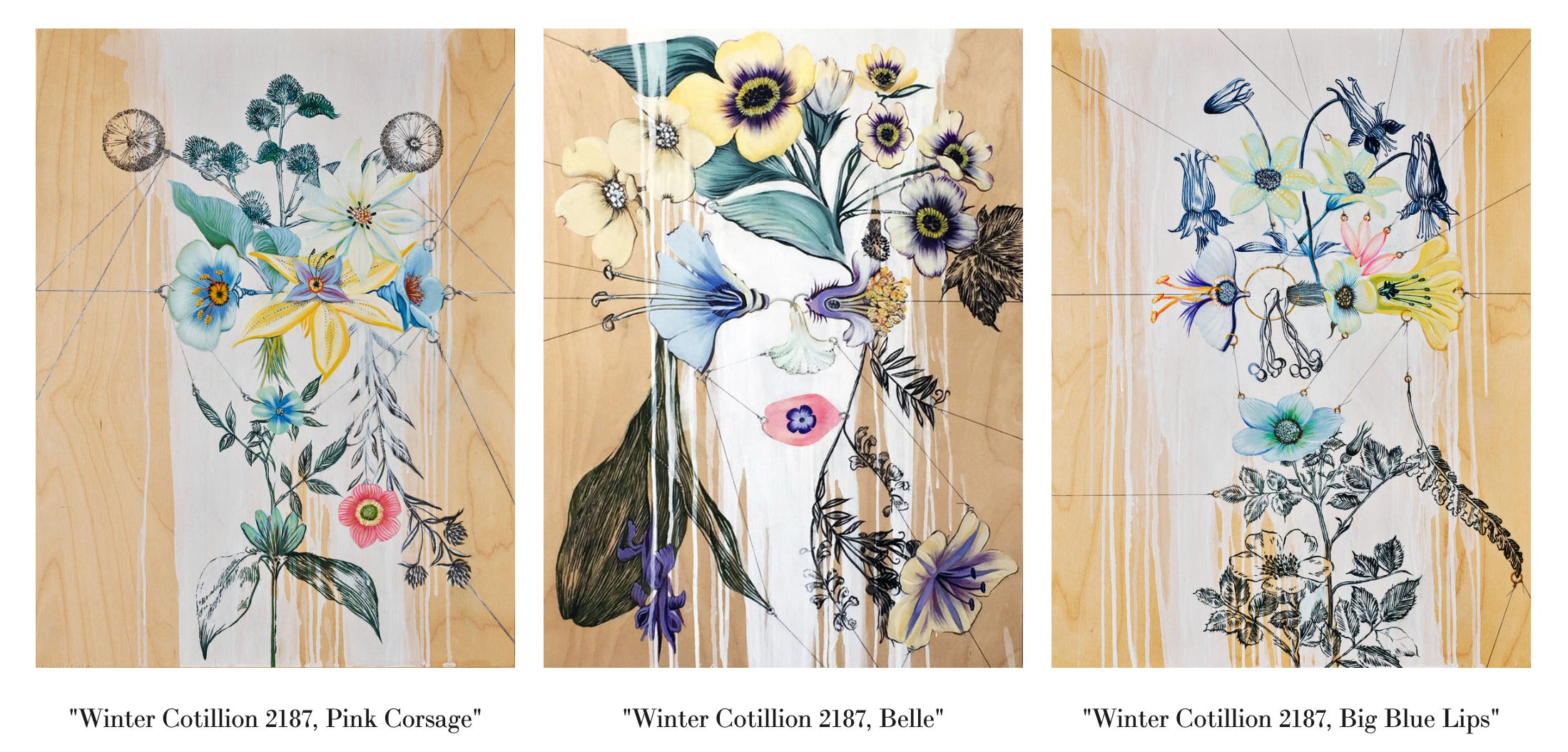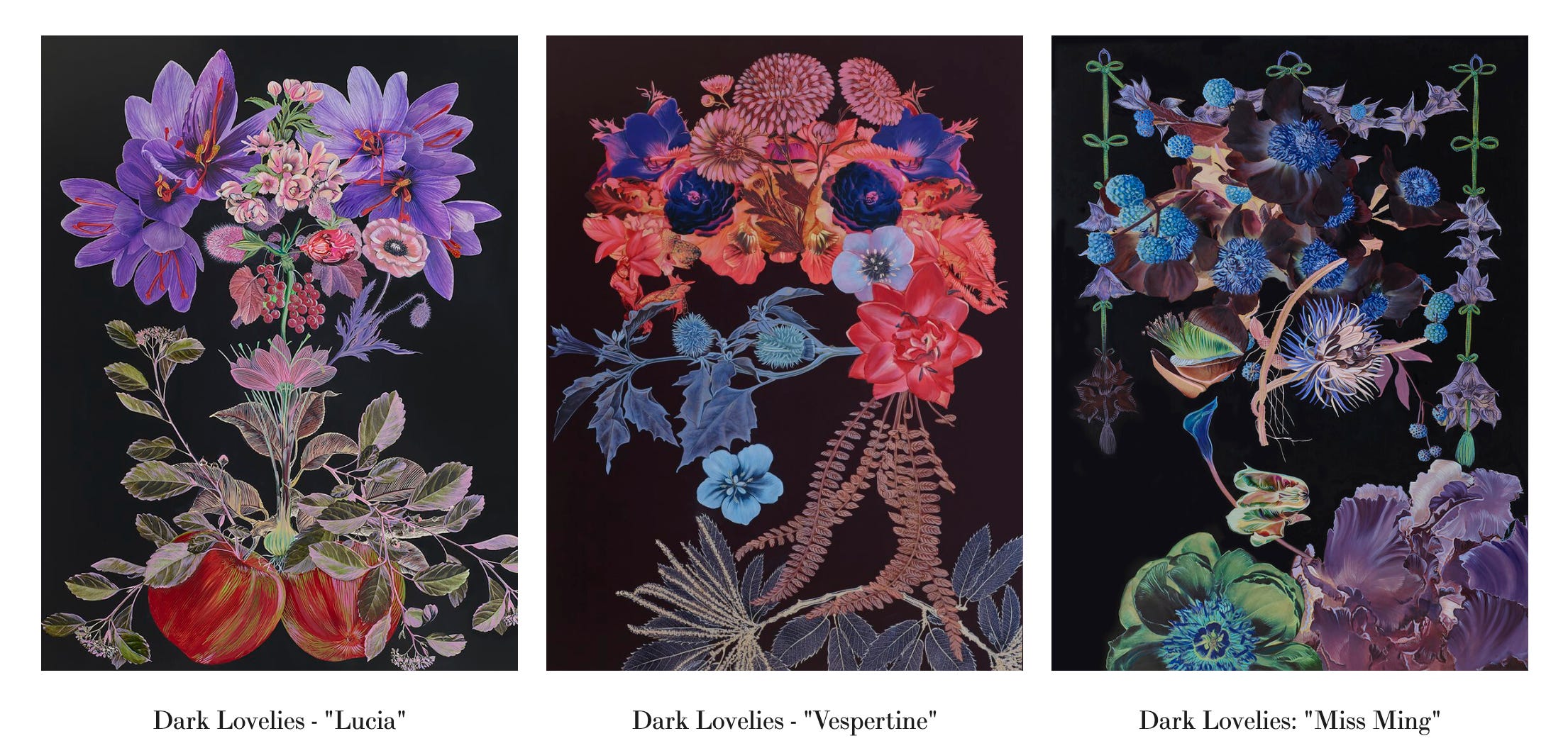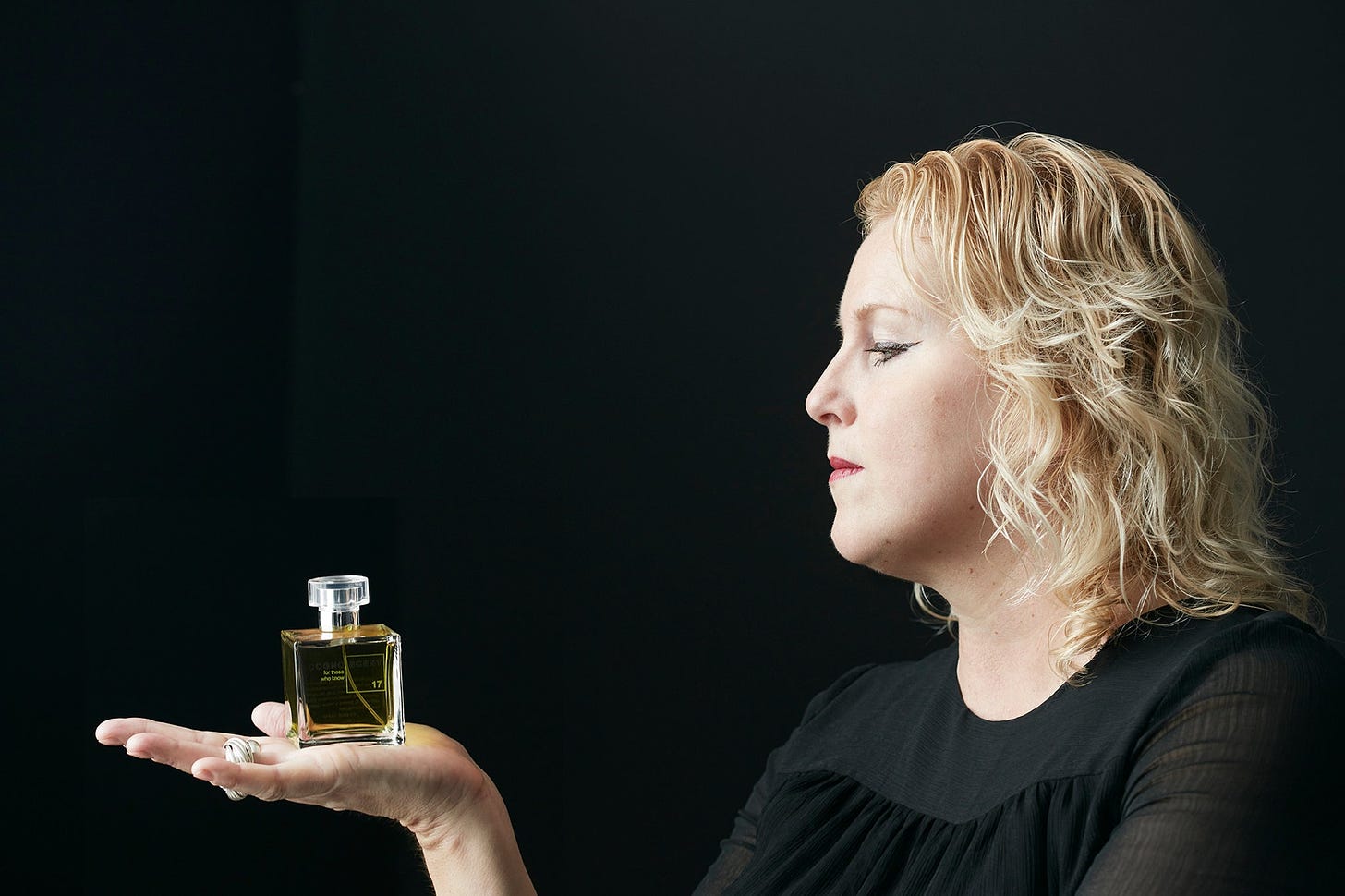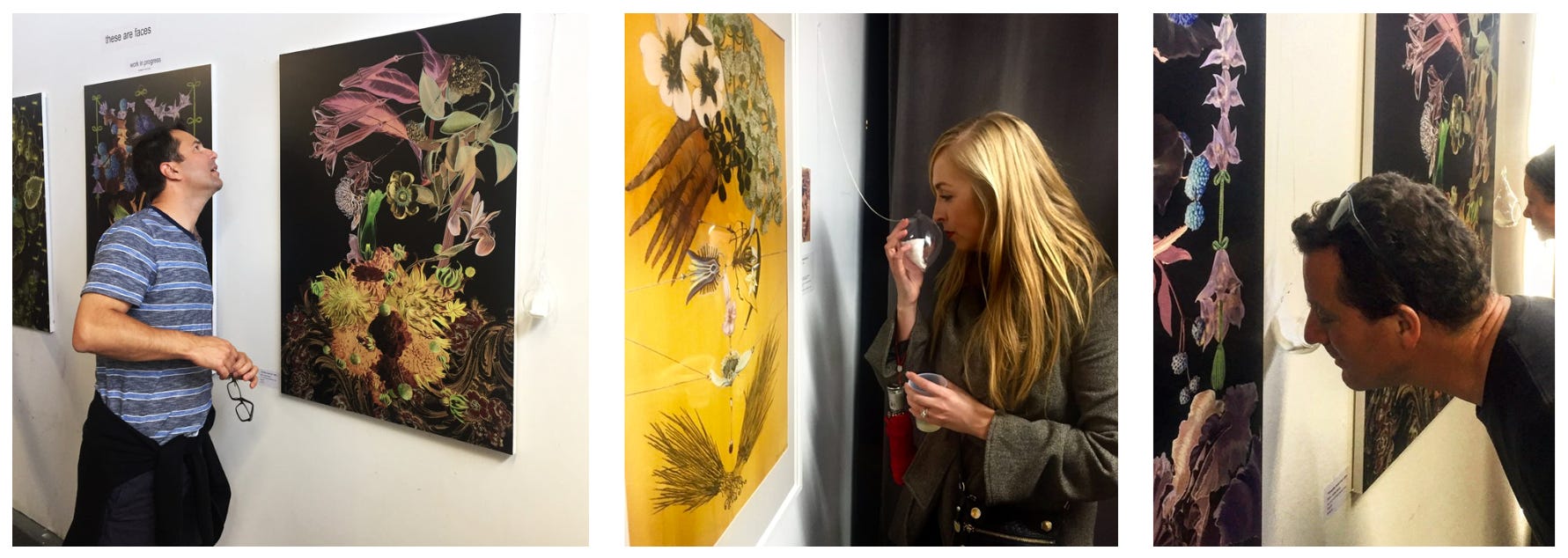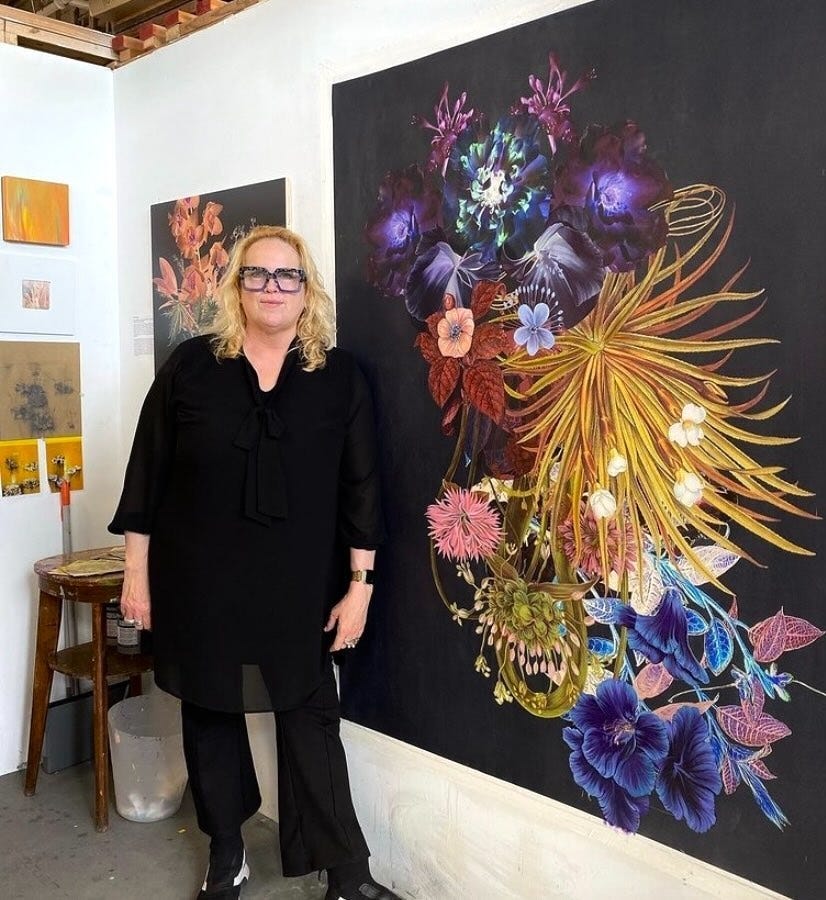Fragrant Brushstrokes: The Synesthetic Art of Dannielle Sergent
In the eclectic sphere of contemporary art, Dannielle Sergent emerges as a compelling figure whose work defies the conventional boundaries of creative expression. An architect of the intangible and a painter of the sensory, Sergent’s oeuvre is a testament to the symbiosis of varying artistic disciplines. With a background as diverse as the media she employs—from the structural integrity of architecture and interiors to the ephemeral allure of perfumery, and the tactile tradition of oil painting—her work is an exploration at the nexus of natural forms and human ingenuity.
Sergent’s art is rooted in the balance between the organic and the synthetic, the traditional and the avant-garde. Her use of diverse materials in design and the intricate juxtapositions in her paintings exemplify this harmony, creating experiences that resonate with depth and complexity.
The “Botanical Portraits” that have become the hallmark of Sergent’s work over the past decade are emblematic of this narrative—a visual allegory where the beauty of flora is interwoven with humanistic themes, reflecting a contemplation of identity, temporality, and our intrinsic connection to the natural world. In Sergent’s realm, flowers are not mere subjects of aesthetic admiration but are potent symbols and storytellers, capturing the grandeur of life’s tapestry in their delicate forms.
Thus, as we embark on this exploration of Dannielle Sergent’s art, we find ourselves at the intersection of various artistic pathways. Here, the tangible meets the intangible, the sensory is infused with the conceptual, and every creation is a layer in the profound mosaic of human experience, waiting to be unraveled and understood.
A Philosophical Vision Transcending Mediums
In her article LAYERS: Pushing Through the Arts to Perfume, Sergent muses on the intimacy of layers that chart the path and define the final perception of the uppermost strokes. It is an artistic choice, she notes, akin to a carefully guarded secret: to conceal or to reveal. This interplay of layers becomes a dialogue with the viewer, one where the surface may catch the eye, but the hidden strata hold the essence. Warhol’s superficiality is contested by the profundity of what lies beneath, a nod to the complexity of existence and the multifaceted nature of perception.
This philosophy of depth and surface extends beyond the canvas for Sergent. In her design work, the interplay of light and shadow, the textural contrasts, and the deliberate use of space speak to an architectural narrative that also adheres to a “fat over lean” structure. The physical laws of gravity in architecture, with its foundation bearing the weight of all that stands above, parallels her layered approach to visual art. Sergent’s work acknowledges the base—that which grounds and gives rise to form—whether it is in the hidden underpinnings of a building or the initial washes of paint on a canvas.
The wavelengths of color become a language through which Sergent communicates depth, not just visually but experientially. By mastering the warm and cool dichotomies, she choreographs a dance of intimacy and withdrawal, pulling the audience into a visual embrace or gently pushing them to a contemplative distance.
In Sergent’s philosophy, each stroke, each layer, carries a weight beyond its visual contribution. They are the silent narrators of a grander story, one that weaves through the tapestry of her various artistic expressions. In this way, Sergent’s oeuvre becomes a living philosophy, where the interplay between the layers—the seen and unseen, the overt and covert—invites a contemplative journey into the very heart of her creative ethos.
The Botanical Portraiture - An Intersection of Technology and Tradition
Venturing into the visual domain of Dannielle Sergent’s art, one is immediately captivated by the arresting beauty of her “Botanical Portraits.” These compositions transcend mere reflections of the natural world, embodying a sense of purposeful distortion, a deliberate reconfiguration of reality. Sergent’s oil paintings, which we will explore in more detail, are not just artistic creations; they are embodiments of distinct personalities, each a unique “botanical portrait,” representing a profound commentary on the symbiotic relationship between the organic and the technological.
In the following, we analyze some phases of Dannielle Sergent’s work.
The trio of works on 22” x 30” Mixed Media on 300g Cotton Rag Paper from 2016 unveils Sergent’s sophisticated engagement with botanical art traditions. Each piece is a celebration of botanical splendor, deftly rendered with such finesse that the plants transcend their role as subjects to become the very essence of character and form. Here, flowers, leaves, and branches are not merely depicted; they are transfigured into the skin and hair of a novel personification of nature.
“M’ Lady” echoes the precision of 18th-century botanical illustrators like Pierre-Joseph Redouté, paired with the ornamental flair reminiscent of Aubrey Beardsley’s ink work.
“Primo” offers a softer contrast with its verdant backdrop, suggesting the meticulous naturalism of the Pre-Raphaelites and the stylized nature motifs characteristic of William Morris.
“Carlota, Miss Daucus Carota” with its golden canvas, channels the decorative spirit of Art Nouveau, evoking Alphonse Mucha’s sinuous lines, while also alluding to the symbolic richness found in Gustav Klimt’s gold leaf embellishments.
Together, these works reflect a synthesis of historical reverence and modernity, melding detailed naturalism with symbolic and decorative elements, suggesting influences from Redouté’s botanical precision to Klimt’s symbolic opulence. Sergent’s artistry transforms flora into a tapestry of historical homage and contemporary expression.
The second trio of works, part of “Winter Cotillion 2187,” crafted in mixed media on wood panels from 2017, encapsulates the evolution of Dannielle Sergent’s artistic exploration. Each piece is a discrete narrative, a botanical vignette that captures the fleeting grace of nature on a static medium. In these works, Sergent articulates a visual language where the medium’s texture becomes an integral part of the artwork’s overall sensory appeal, and the wooden canvas itself contributes to the organic narrative.
The titles—“Pink Corsage,” “Belle,” and “Big Blue Lips”—suggest a personification of each arrangement, infusing the flora with character and story. The careful composition and selective coloration of these pieces create a sense of orchestrated spontaneity, reminiscent of the Japanese art of Ikebana, where every element is purposeful and poised.
Sergent’s work here continues to reflect the blend of influence and innovation seen in her previous pieces. The bold yet harmonious use of color and form pays homage to the Modernist movement, while the ethereal quality of the subjects evokes the dream-like surrealism of artists like Salvador Dalí. The dimensionality and emphasis on individual floral elements recall Georgia O’Keeffe’s larger-than-life blooms, celebrating the natural form's intrinsic beauty and power.
In “Winter Cotillion 2187,” Sergent’s own signature style—marked by a delicate balance between detail and abstraction—emerges distinctly, showcasing her evolving journey as an artist who both honors and transcends her influences.
In the "Dark Lovelies" series, with pieces spanning from 2019 to 2023, Dannielle Sergent elegantly charts her journey through a visual and philosophical landscape. These works articulate a delicate interplay of flora against the profound stillness of dark backgrounds.
In "Lucia," the interplay of shadow and light transcends mere technique, becoming a vessel for the silent narratives that flowers can tell. Its arrangement gently echoes the essence of Arcimboldo's allegories, where plants and natural forms carefully assemble into meaningful wholes, suggesting a subtle dialogue between the seen and unseen.
“Miss Ming,” with its cool, contemplative hues, reflects the introspective quality found in the Blue Period works of Picasso, as well as the textural complexity of a Van Gogh night sky. The deliberate arrangement of its botanical elements suggests a narrative as intricate as the layered brushwork of Gustav Klimt’s "Golden Phase."
“Vespertine,” rendered in warm reds and oranges, evokes the passionate energy of the Fauvist movement. Its pronounced forms and bold vitality echo the expressive power of flowers in Georgia O’Keeffe’s work, with a hint of the dynamic composition found in the action paintings of Jackson Pollock.
Collectively, these works convey Sergent’s deeper contemplation of existence, identity, and the natural world. Her botanical portraits, steeped in a rich tapestry of historical and contemporary artistic influences, invite viewers to explore the multifaceted layers of human emotion and thought, just as the Renaissance and Baroque masters imbued their subjects with scientific curiosity and rich allegory. Sergent’s floral compositions are thus not merely visual delights but are steeped in the philosophical, marrying the beauty of creation with the profound depths of human experience.
On the technical side, Sergent’s approach to blending digital prints with oil on wood transcends mere layering, signifying a deeper interplay between initial concept and evolving artwork. The foundational digital layer sets the stage, only to be metamorphosed by her intuitive brushstrokes into a composition that is uniquely Sergent’s. This method showcases a seamless integration of classical technique with modern technology, illustrating her distinctive capacity to transmute a predefined image into an original, vibrant piece that resonates with her creative ethos.
In summary, Sergent's artistic development could be seen as a rich tapestry woven from classical, modern, and contemporary art threads. Her work pays homage to the masters of light, line, and color while simultaneously breaking new ground. Through her paintings, Sergent appears to engage in an ongoing dialogue with the artists who have preceded her, reinterpreting their languages to articulate her own unique visual vocabulary.
The “Inside Flowers” series
This series, developed in the Winter of 2022/23, diverges from Dannielle Sergent’s “Botanical Portraits,” presenting a series of acrylics on paper that delves into the essence of floral anatomy. Stripped of color, these works focus on the interplay of light and shadow, form and texture, capturing the inner architecture of each bloom. The monochromatic palette emphasizes the structural beauty of flowers, often overlooked in favor of their vibrant colors. Unlike her previous work, which often infuses botanicals with personality and narrative, "Inside Flowers" invites a contemplative look at the pure form, drawing attention to the subtle elegance inherent in the natural design of flora. These pieces stand apart as a study of organic symmetry and the quiet complexity of nature’s artistry.
Conclusion: The Synesthetic Symphony of Sergent’s Art
As we approach the denouement of our journey through Dannielle Sergent’s artistic landscape, it becomes abundantly clear that her work transcends the visual to offer a multi-sensory experience. Sergent’s art is not merely to be observed; it is to be lived and breathed. To fully immerse oneself in the world Sergent has crafted, a visit to her website, Botanical Portraits, becomes an inviting prospect. Here lies the gateway to exploring her collections further, to understand the intertwining of sight and scent that characterizes her exhibitions.
In the curated spaces where Sergent’s works are displayed, one encounters an atmospheric alchemy that is rare in the world of art. Each painting is often paired with a unique fragrance, conceptualized and created by Sergent herself. These olfactory creations are not mere afterthoughts but integral components of the artwork, designed to enhance and amplify the visual narrative. The perfumes serve as the invisible medium, adding depth and dimension to the botanical portraits, enveloping the viewer in a holistic sensory tableau.
This innovative pairing is a testament to Sergent’s belief in the profound interconnectedness of our senses and the experiences they procure. The fragrances are composed to echo the themes, colors, and textures of her paintings, creating a synesthetic experience where the viewer can truly sense the essence of the artwork. In Sergent’s exhibitions, one does not simply observe a “Botanical Portrait,” one steps into it, as the fragrance wafts through the space, transporting the viewer into the world Sergent has so intricately crafted.
It is this fusion of the olfactory with the visual that marks Sergent’s work as a beacon of experiential art. Her shows become immersive encounters that engage not just the eyes but the very soul of the onlooker. By associating each painting with a perfume, Sergent extends an invitation to explore her art on a level that is deeply personal and profoundly emotive.
As one navigates through the vibrant hues and evocative scents of Sergent’s work, the experience is akin to wandering through a garden of earthly delights. The flowers in her paintings, coupled with their aromatic counterparts, do more than captivate; they transport, they communicate, they live. Sergent’s creations remind us that art can be a bridge to the sublime, a portal to a realm where the beauty of the natural world melds seamlessly with the sensorial depth of human creativity.
We encourage readers not only to view but to experience the full spectrum of Sergent’s artistry. In her exhibitions, one finds a unique opportunity to witness the unity of the senses, a symphonic celebration of art's power to move and to transcend. Sergent’s Botanical Portraits await—each a door to a realm where the essence of art is not just seen, but felt, inhaled, and profoundly understood.
Dannielle Sergent lives and works in San Francisco. You can enjoy her works at the next Art Explosion Open Studios event in San Francisco around the end of September 2024. More exhibitions can happen in the meantime; look at the News section on Botanical Portraits, her website, for details.



